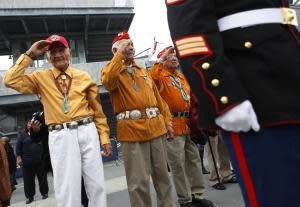 The Upshot
The UpshotOn Veterans Day, Navajo Code Talkers honored

During World War II, Navajo members of the Marine Corps used a code based on their native language to allow platoons to communicate without Japanese intelligence agents being able to decipher what they were saying. This Veterans Day marks official recognition of the Navajo "Code Talkers" and their crucial part in the war effort.
A group of Code Talkers rang the opening bell at the New York Stock Exchange this morning, and the state of New Mexico dedicated a stretch of highway to them yesterday, reports USA Today.
The idea for the Code Talkers is said to have come from Philip Johnston, the son of a Protestant missionary who grew up on the Navajo reservation, which spans parts of New Mexico, Arizona and Utah, in the "four corners" region of the Southwest. Johnston, who spoke the language, convinced the Marines to enlist Navajo recruits, and to use the language — for which no books exist — as a secure communications tool.
In 1942, a group of 29 Navajo devised the complex code, assigning Navajo words for each letter of the English alphabet; they also adapted the Navajo vocabulary to describe weapons and form combat-related phrases. The Navajo word for tortoise, for instance, "chay-da-gahi," meant tank, and "ne-he-mah," which means our mother, meant America.
In the Pacific Theater, where platoons often lacked sophisticated communications equipment and made hard landings on beaches, the code was especially useful, Geoffrey Wawro, a military historian, told the paper. The Japanese never cracked it.
"It helped reduce Marine casualties," said Wawro.
The military trained 400 Navajo Code Talkers, but fewer than 100 are believed to be alive today. Two of them, Keith Little and Frank Chee Willetto, are now working with a foundation to raise money for a Code Talkers museum and veterans center.
The Code Talker initiative didn't mark the only Navajo contribution to the war effort. War planners used uranium from Navajo mines to build the atomic bombs dropped on Hiroshima and Nagasaki; the same uranium reserves went into the postwar arms buildup against the Soviet Union's nuclear arsenal. Years after the mines closed, rates of cancer and other deadly diseases shot up among the tribe — something that researchers have linked to radioactive contamination on large parts of the reservation. Only in the last few years has the government begun to make significant reparations to the Navajo.
(Photo: AP/Seth Wenig)

